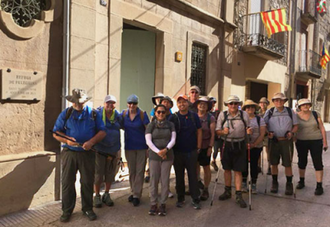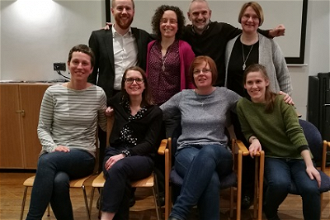Spain: In St Ignatius' Footsteps

Source: Jesuits in Britain
The Farm St Church Camino in the steps of St Ignatius set off on Sunday for two weeks of walking and pilgrimage in northern Spain.
The group of 19, led by Fr Dominic Robinson SJ, landed in Barcelona. Their first stop has been Verdu, at the Shrine and birthplace of St Peter Claver, the 17th century Jesuit priest known as the 'slave to the slaves' for his work with the slaves of what is modern day Colombia. "The opening Mass and the first day morning prayer were dedicated to the victims of human trafficking and that we may learn from Ignatius' journey in life how to embrace freedom" said Fr Dominic. "Praying for Farm Street, especially here" he concluded, announcing the beginning of the 16km walk to Cervera.
This first part of the Camino sees the pilgrims through the beautiful green valleys and hills of Catalunya that St Ignatius knew very well, stopping at churches, shrines of Our Lady and in small villages and towns as he did. Next they will make their way around the breathtaking mountain of Montserrat, known as a place of profound peace and spirituality, to reach the great Abbey of Our Lady of Montserrat. Here, the founder of the Society of Jesus spent three nights in prayer, laid down his sword at the feet of the Madonna and resolved to follow Christ.
The final steps will follow St Ignatius to the town of Manresa, where he settled and lived the life of 'the pilgrim' as he composed the Spiritual Exercises.
Next, they will make their way around the breathtaking mountain of Montserrat, known as a place of profound peace and spirituality, to reach the great Abbey of Our Lady of Montserrat. Here, the founder of the Society of Jesus spent three nights in prayer, laid down his sword at the feet of the Madonna and resolved to follow Christ.
The final steps will follow St Ignatius to the town of Manresa, where he settled and lived the life of 'the pilgrim' as he composed the Spiritual Exercises.
The pilgrimage, however, is not all walking. A Camino is a spiritual as well as a physical exercise. During the journey, the group stops for prayer at particular places, guided by St Ignatius to reflect on their own response to Christ.
In his autobiography, St Ignatius charts his own progress along the way, meditating on his call. "So our prayer will reflect this as we contemplate where God is working in our lives," explained Fr Dominic: "each day we will celebrate Mass as the high point of the day and eat dinner together."
The end of the walk will lead the group back to Barcelona, home to St Ignatius for several years in two periods of his life. They will spend few days of rest, prayer, and review of the Camino experience in the Spiritual Exercises Centre, with some visits to the sites associated with the founder of the Society. There will be time for general sightseeing as well, shopping and enjoying the wonders offered by the city.
The question arising not only from the good participation to this experience, but also from the recent interest shown by more and more groups into this religious journey is: why is pilgrimage becoming more popular?
Fr Dominic Robinson SJ said "it is a different way of making a retreat. Some find it easier to come closer to God in silence and with an individual prayer guide. Others prefer to do something physical and in companionship.
"Walking in the steps of St Ignatius is a very special way of connecting with the Spiritual Exercises. In his diary, our founder calls himself simply 'the pilgrim' and describes how, during his Camino in 1522 across northern Spain, from Loyola to Manresa, he moved from freedom to detachment to indifference. He recalls the dedication of his sword to Our Lady, and his taking refuge in the cave in Manresa, where the Spiritual Exercises were written.
"As a group" Fr Dominic continued "we will reflect on St Ignatius' teachings. It's a bit like the Canterbury Tales - as we journey, we talk, we sing, we pray, we eat and drink together, we share where we are on our faith journey."


















